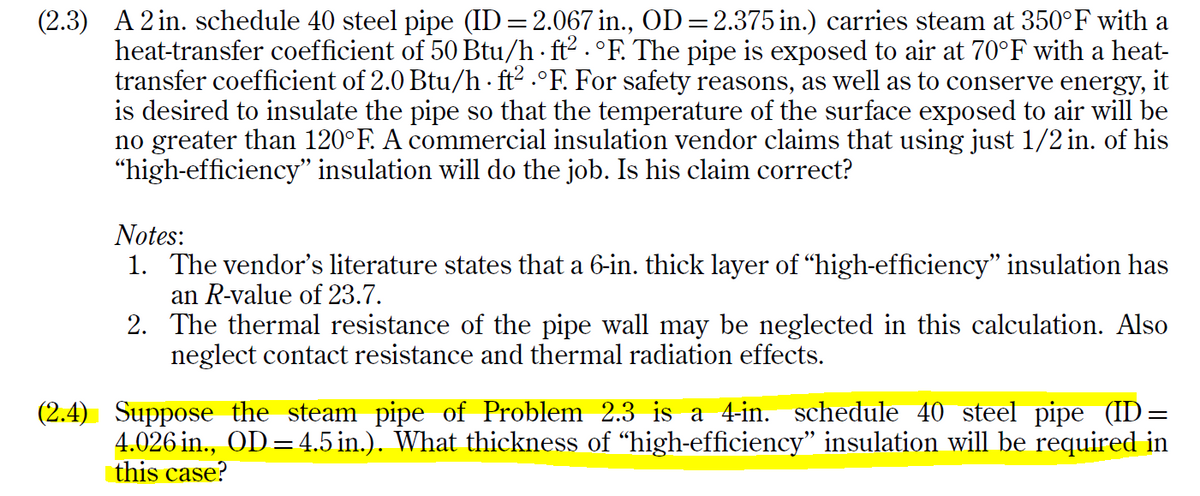(2.4) Suppose the steam pipe of Problem 2.3 is a 4-in. schedule 40 steel pipe (ID= 4.026 in., OD=4.5 in.). What thickness of "high-efficiency" insulation will be required in this case?
(2.4) Suppose the steam pipe of Problem 2.3 is a 4-in. schedule 40 steel pipe (ID= 4.026 in., OD=4.5 in.). What thickness of "high-efficiency" insulation will be required in this case?
Principles of Heat Transfer (Activate Learning with these NEW titles from Engineering!)
8th Edition
ISBN:9781305387102
Author:Kreith, Frank; Manglik, Raj M.
Publisher:Kreith, Frank; Manglik, Raj M.
Chapter7: Forced Convection Inside Tubes And Ducts
Section: Chapter Questions
Problem 7.3DP
Related questions
Question
i need the exercise 2.4 please show details.
thermal conductivity value of the insulation IS 0.021 Btu/hft2°F

Transcribed Image Text:(2.3) A 2 in. schedule 40 steel pipe (ID=2.067 in., OD=2.375 in.) carries steam at 350°F with a
heat-transfer coefficient of 50 Btu/h · ft . °F. The pipe is exposed to air at 70°F with a heat-
transfer coefficient of 2.0 Btu/h · ft² .°F For safety reasons, as well as to conserve energy, it
is desired to insulate the pipe so that the temperature of the surface exposed to air will be
no greater than 120°F. A commercial insulation vendor claims that using just 1/2 in. of his
“high-efficiency" insulation will do the job. Is his claim correct?
Notes:
1. The vendor's literature states that a 6-in. thick layer of "high-efficiency" insulation has
an R-value of 23.7.
2. The thermal resistance of the pipe wall may be neglected in this calculation. Also
neglect contact resistance and thermal radiation effects.
(2.4) Suppose the steam pipe of Problem 2.3 is a 4-in. schedule 40 steel pipe (ID=
4.026 in., OD= 4.5 in.). What thickness of "high-efficiency" insulation will be required in
this case?
Expert Solution
This question has been solved!
Explore an expertly crafted, step-by-step solution for a thorough understanding of key concepts.
Step by step
Solved in 2 steps

Knowledge Booster
Learn more about
Need a deep-dive on the concept behind this application? Look no further. Learn more about this topic, mechanical-engineering and related others by exploring similar questions and additional content below.Recommended textbooks for you

Principles of Heat Transfer (Activate Learning wi…
Mechanical Engineering
ISBN:
9781305387102
Author:
Kreith, Frank; Manglik, Raj M.
Publisher:
Cengage Learning

Principles of Heat Transfer (Activate Learning wi…
Mechanical Engineering
ISBN:
9781305387102
Author:
Kreith, Frank; Manglik, Raj M.
Publisher:
Cengage Learning